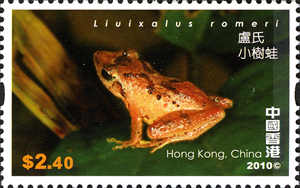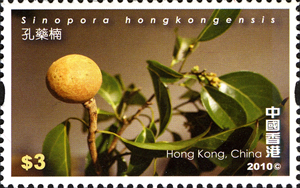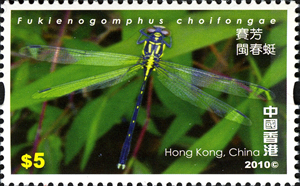The United Nations has proclaimed 2010 as the International Year of Biodiversity. Therefore Hong Kong Post presents the commemorative stamp set of four special stamps featuring endemic species including the Hong Kong paradise fish Macropodus hongkongensis, Romer's tree frog (the smallest frog species found in Hong Kong), Sinopora hongkongensis (a plant first discovered in Tai Mo Shan which is new to science) and Fukienogomphus choifongae (a dragonfly first discovered in Wu Kau Tang which is also new to science).The stamps were issued on June 30, 2010.

Macropodus hongkongensis is a new species endemic in Hong Kong and should be treated as an endangered species. Compare with the related species Macropodus concolor, Macropodus hongkongensis have some discrepancies like the scale pigmentation, appearance overall, the pelvic fin rays .
Macropodus hongkongensis has black spots on the top of the head and may have blotches on the back (around the anterior portion of the doral fin). In addition, it has a thin black margin along the anal fin. These characters are lacking in Macropodus concolor. An additional distinguishing feature is the pelvic fin rays: the first soft pelvic fin ray of Macropodus. hongkongensis is white; it is red in Macropodus concolor. Furthermore, Macropodus hongkongensis has an opercular spot that Macropodus concolor lacks or expresses indistinctly. There are also subtle differences in the scale pigmentation.
As known, the two species are geographically different, and may have evolved independently from populations of the widely distributed Macropodus opercularis in Vietnam (concolor) and southern China (Macropodus hongkongensis).

Liuixalus romeri
Romer's Tree Frog (Liuixalus romeri) is a species of frog endemic to Hong Kong. With an average snout-vent length of 1.5 - 2.5 cm, it is the smallest amphibian recorded in the territory.The habitat of the frog is well-wooded areas near a small stream or other water source suitable for breeding. The creature usually sits on low bushes, buries itself in fallen leaves, or rests on bare ground. The frog has been recorded solely from 4 of the outlying islands in Hong Kong, namely Lantau Island, Lamma Island, Po Toi Island and Chek Lap Kok.
Over 200 individuals of the species were rescued from Chek Lap Kok in 1992, before the construction of the Hong Kong International Airport. The captives were bred successfully and the offspring were released into 8 selected sites in Hong Kong Island and New Territories. The frogs in 7 of the sites survived. Surprisingly, a very small number of the creatures also survives in Chek Lap Kok.
As an endangered species, Romer's Tree Frog is protected under the law of Hong Kong (Wild Animals Protection Ordinance, Cap. 170). Part of Ngong Ping in Lantau, a site that supports the largest population of the frog, has been designated as a Site of Special Scientific Interest in May 1999.

Sinopora hongkongensis
Sinopora hongkongensis is plant tree which can grow up to 16 m tall with branchlets are reddish brown. Petiole slender, 1-2 cm, flat adaxially; leaf blade abaxially pale green and glaucous. Flowers are greenish yellow, consist of 6 tepals , densely tomentose. Style tomentose at base. Fruit yellowish brown, to 4 cm in diam., with persistent accrescent tepals at base when young. This species is very rare and its conservation status is Critically Endangered (CR B2ab(v)). It occurs in the Country Park of Hong Kong under statutory protection.

Fukienogomphus choifongae
Fukienogomphus choifongae, first discovered at Wu Kau Tang in the northeastern New Territories in 2004 and then was identified as a species new to science

No comments:
Post a Comment